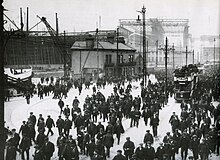Sir William Arrol & Co.
| Company type | Public |
|---|---|
| Industry | Civil engineering |
| Founded | 1873 |
| Defunct | 1969 |
| Fate | Acquired |
| Successor | Clarke Chapman |
| Headquarters | Glasgow, Scotland |
Key people | Sir William Arrol (Chairman) |
Sir William Arrol & Co. was a leading Scottish civil engineering and construction business founded by William Arrol and based in Glasgow. It built some of the most famous bridges in the United Kingdom including the Forth Bridge and Tower Bridge in London.
Early history
The company was founded by William Arrol at Dunn Street in Dalmarnock in Glasgow in 1873.[1] It later expanded to incorporate the Parkhead Crane Works in Nuneaton Street.
Notable projects

Bridges
Bridges built by the company include:
- The Caledonian Railway Bridge across the River Clyde completed in 1878
- The Tay Rail Bridge completed in 1887
- The Forth Bridge completed in 1890
- Tower Bridge in London completed in 1894
- North Bridge in Edinburgh completed in 1897
- Redheugh Bridge in Newcastle upon Tyne completed in 1901
- Connel Bridge completed in 1903
- The Nile Bridge at Cairo completed in 1908
- Middlesbrough Transporter Bridge completed in 1911
- Warrington Transporter Bridge completed in 1916
- Keadby Bridge completed in 1916
- Southwark Bridge in London completed in 1921
- White Cart Bridge completed in 1923
- Jubilee Bridge (Walney) completed in 1908
- Jubilee Bridge (Queensferry) completed in 1927
- Corporation Bridge in Grimsby completed in 1928
- Wearmouth Bridge completed in 1929

- Tsoelike Suspension Bridge in Lesotho completed in 1930
- Forth Road Bridge completed in 1964
- Deptford Railroad Bridge completed in 1964
- Severn Bridge completed in 1966
- The second Craigellachie Bridge completed in 1970
- The Humber Bridge completed in 1981
Cranes
- Titan Clydebank, completed in 1907
- Titan Crane, Fairfield, completed in 1911
- Titan Crane, James Watt Dock Crane, completed in 1917
- Titan Crane, Barclay Curle, completed in 1920
- Blocksetter Travelling Titan (South African Harbours and Railways); for use at Durban, completed prior to 1932[2]
- Blocksetter Travelling Hercules (South African Harbours and Railways); for use at Table Bay, completed prior to 1932[2]
- Blocksetter Travelling Hercules; for use at Ceuta, completed prior to 1932[2]
Titanic

The company was contracted by Harland and Wolff Shipyard, Belfast, to construct a large gantry (known as the Arrol Gantry) for the construction of three new super-liners, one of which was called the RMS Titanic. Like the ships themselves, the gantry crane was one of the largest built at the time, comparing with transporter bridges in length, height and capability.
Hikitia

The company also built the crane for the Hikitia in 1926, which is thought to be the last fully operational self-propelled steam crane in the world.
Demise of the business
The company was acquired by Clarke Chapman in 1969 and the Dalmarnock Works were closed in 1986.[3]
References
- ^ National Archives
- ^ a b c Arrol Catalogue ca. 1932
- ^ NZR Cranes Archived 3 March 2016 at the Wayback Machine
External links
- British companies established in 1873
- Companies disestablished in 1969
- Companies based in Glasgow
- Construction and civil engineering companies of Scotland
- 1873 establishments in Scotland
- 1969 disestablishments in Scotland
- Defunct companies of Scotland
- Construction and civil engineering companies established in 1873
- Bridgeton–Calton–Dalmarnock
- Defunct construction companies
